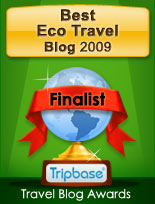.jpg)
Part of me is still amazed by the fact that what seems like a simple panel, left sitting in the sun, can store enough power to charge an ipod or a phone. There is something almost supernatural about using this kind of free energy, a feeling I really like!
A little while ago we decided to look for the ultimate personal solar charger, a unit that would do it all and do it in style. Our research took us to Freeloader, arguably the forerunner in personal solar technology. Their solar chargers are well known in the outdoor/adventure community and their new Freeloader Pro is regarded as the top expression of the art of personal solar technology. We decided to put it to the test.
It should be pointed out at this point that we carry a lot of technology on some of our trips. The nature of what we do and the areas we do it in means that we need a whole array of gear from portable GPS devices to the humble ipod and of course phones, laptops and cameras.
The Freeloader Pro is a welcome addition to our traveling gadget shop as it really is very portable; the shell is well designed and folded up takes no more room than a first generation mobile phone or PDA. We were rather worried at first, our research brought up a whole array of negative reviews on the first generation Freeloader model, people were getting varied results, especially in the UK and part of me felt the Freeloader Pro would have the same shortfalls, on the other hand it is the PRO version so expectations were high. That being said I packed it along with the all important camera battery charger, the AA battery charger (an optional extra) and finally the right connections for my iphone, now to find some sun!
This test was carried out in the middle of July in Europe so it probably won’t compare to what you would expect on a typical winter’s day in England, on the other hand it is designed for travel usage so some lucky people will end up using it on the move on some lovely tropical island. I allowed the charger its first full charge via USB (as specified in the instructions) then used it to power-up my camera battery which it did very well. The next charge was going to be fully solar. On a remote beach in France I set the panels for the first proper solar test (a little red double LED shows you the correct charging status) and sat the unit on my towel whilst I went about the typical tourist thing… I gave the unit a whole 6 hours of charge in direct light after which I checked the battery status: 2 out 4 bars on the light ‘halo’ (a neat charge indicator). Not a huge amount but it felt like it would be enough to power my iphone. At the end of a busy beach day I connected it all up and, hey presto, the phone lit up, in a few minutes I was able to charge the phone from half battery to full, for free. Very exciting for a solar newbie!
The next 4 days the solar charger was charged in a similar way, never really ever getting close to full charge, it powered my iphone (notoriously power hungry), my camera once and a portable usb speaker that was always fully charged in a matter of minutes. For my type of usage it turned out to be a nifty little gadget and well worth the investment. The price is a little on the high side when you compare it to the Freeloader and the AA/AAA battery charger as an optional extra seemed a little much but overall you do get the feeling the products are well designed and they don’t feel cheap in anyway.
I think that all in all it can make for an excellent addition to anyone’s travel packing list, it works extremely well as a backup charger and will give you that extra safety net when you are in a remote location. It would not be something I would rely on as my only means of power though, the AA charger never really worked for me, the charge was always minimal and never enough to keep the GPS unit’s high capacity batteries running. On the other hand, I will most definitely be packing it on my next trip, let’s hope it’s to a lovely Caribbean island!
Available from www.solartechnology.co.uk for £69.99 inc VAT
Technical Specification:
Technical Specs Freeloader Pro
• 200mA premium quality crystalline solar cells
• 1600mAh environmentally friendly Li-ion battery – typical battery life is 2 years.
• Freeloader’s solar panels can charge its internal battery in as little as 8 hours or 3 hours when using the supplied USB charging cable
• Supplied with a Master Cable for connecting to a device or CamCaddy and for charging Freeloader Pro from a computers USB
• Supplied with ten adaptors to fit the following:
1) iPod, iPhone, iPhone 3g, iPhone 3gs iTouch, Nano etc
2) Nokia phones using both standard and mini adaptors (2 supplied)
3) All current Samsung phones (2 supplied)
4) All current LG phones
5) All current Sony Ericsson phones
6) Nintendo DS Lite / DSi
7) Mini USB adaptor for Motorola phones, Blackberry and most smartphones, Garmin /
SatMap and most GPS, Bluetooth headsets, PDA’s
8) 4mm tip for Sony PSP, Archos and most MP4 players, 2 way radios, portable DVD players, e-books, digital cameras and PDA’s
• Impact resistant, rust free aluminium body.
• Freeloader holds its battery charge for up to 3 months
• Supplied with detailed user manual
Size – 150 x 63 x 20mm
Weight – 174g
CamCaddy (Included with FreeloaderPro)
• Max operating voltage – 9.5v
• Max battery depth – 67mm
Size – 130 x 71 x 30mm
Weight – 68g


















